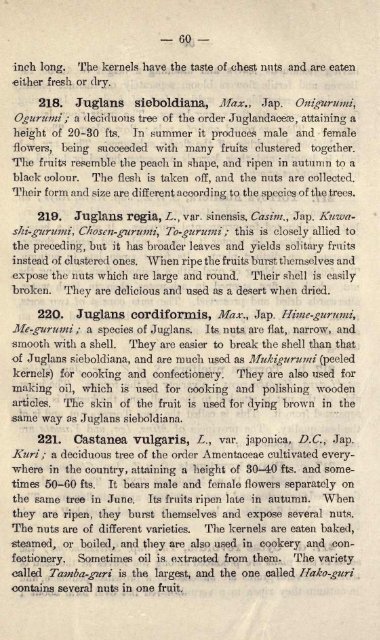Untitled - Library
Untitled - Library
Untitled - Library
Create successful ePaper yourself
Turn your PDF publications into a flip-book with our unique Google optimized e-Paper software.
60<br />
inch long. The kernels have the taste of chest nuts and are eaten<br />
either fresh or dry.<br />
218. Juglans sieboldiana, Max., Jap. Onigurumi,<br />
Ogurzimi ; a deciduous tree of the order Juglandacese, attaining a<br />
height of 20-30 fts. In summer it produces<br />
male and female<br />
flowers, being succeeded with many fruits clustered together.<br />
'The fruits resemble the peach in shape, and ripen in autumn to a<br />
black colour. The flesh is taken off, and the nuts are collected.<br />
Their form and size are different according to the species<br />
of the trees.<br />
219. Juglans regia, L., var. sinensis, Casim., Jap. Knwashi-giirumi,<br />
Chosen-gurumi, To-gurunii ; this is closely allied to<br />
the preceding, but it has broader leaves and yields solitary fruits<br />
instead of clustered ones.<br />
When ripe the fruits burst themselves and<br />
expose the nuts which are large and round. Their shell is easily<br />
^broken. They are delicious and used as a desert when dried.<br />
220. Juglans cordiformis, Max., Jap. Hime-gurumi,<br />
Me-gurumi ; a species of Juglans. Its nuts are flat, narrow, and<br />
smooth with a shell. They are easier to break the shell than that<br />
of Juglans sieboldiana, and are much used as Mukiguruini (peeled<br />
kernels) for cooking and confectionery. They are also used for<br />
making oil, which is used for cooking and polishing wooden<br />
articles. The skin of the fruit is used for dying brown in the<br />
same way as Juglans sieboldiana.<br />
221. Castanea vulgaris, Z., var. japonica, D.C., Jap.<br />
Kuri ; a deciduous tree of the order Amentaceae cultivated everywhere<br />
in the country, attaining a height of 30-40 fts. and sometimes<br />
50-60 fts. It bears male and female flowers separately on<br />
the same tree in June. Its fruits ripen late in autumn. When<br />
they are ripen, they burst themselves and expose several nuts.<br />
The nuts are of different varieties. The kernels are eaten baked,<br />
steamed, or boiled, and they are also used in cookery and confectionery.<br />
Sometimes oil is extracted from them. The variety<br />
called Tamba-giiri is the largest, and the one called Hako-guri<br />
contains several nuts in one fruit.
















